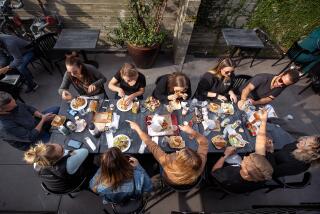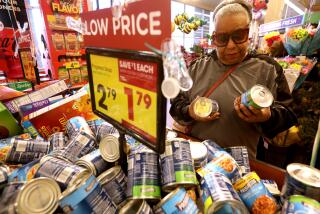Pantry Raid: Change of eating habits needed as couple ages
At first glance, Susan and Herb Eckerling’s kitchen doesn’t look that bad, food-wise. A bowl of fresh fruit graces the tan tile counter, there’s leftover steamed cauliflower in the refrigerator and some quick-cooking oats in the pantry.
But scratch the surface and signs of poor choices and unnecessary deprivations emerge: Susan’s diet is extremely short on whole grains, and neither eats much red meat — even though they like it — because they fear every cut is bad for their health. Herb is a late-night carb grazer who reads food labels selectively, ignoring essential information such as sodium content.
“I look for something that’s low-sugar and low-calories and that’s about it,” he says.
The retired Agoura Hills couple, married 14 years, has some health issues that a better diet could improve. Herb, 74, is pre-diabetic and Susan, 64, is anemic and has high cholesterol. Although they dine home most of the time on fairly healthful foods, they don’t eat enough fruits and vegetables, and Herb’s favorite snack of rye bread with margarine isn’t doing his blood sugar any favors.
Some of what guides the couple’s dietary habits is dubious information, including bromides that date back decades. For instance, Susan has been avoiding most breads, cookies and pasta since a doctor told her in the 1970s that if she didn’t lose the weight she gained during pregnancy by age 25 she never would. The petite woman took the news so much to heart that she steers clear of many grain-based carbs, including ones made from healthful whole grains.
Failing to adjust one’s diet habits may be risky as people age because nutritional needs change. Older people may need fewer calories if they’re not as active as they used to be, and they may have a tough time absorbing some types of vitamins and nutrients. They’re also at higher risk for conditions such as cardiovascular disease, which diet can affect.
On a recent night at the Eckerlings’ comfortable, antique-filled home, Burbank-based registered dietitian Ruth Frechman assesses the situation and is determined to modernize the couple’s approach to eating. She lays down the law about carb intake, which is important for people at any stage of diabetes.
“A carb is a carb,” she tells the Eckerlings. “It’s all digested down to sugar, and once that gets into the bloodstream, your body doesn’t know if you’re eating chocolate or a bagel or an orange.”
“Aren’t there healthier ones?” Susan asks.
“Of course,” says Frechman, who serves as a spokeswoman for the American Dietetic Assn. “You want oranges rather than chocolate to get the vitamins, minerals and fiber.”
Simple carbs, such as bread, cookies and pasta, make their way into the bloodstream faster, which can cause blood sugar levels to spike. Complex carbs that have fiber, such as whole grains and vegetables, take longer to digest and help keep blood sugar steadier.
“If you’re pre-diabetic you want to have some protein at every meal,” Frechman says. “Protein and fiber will help level off your blood sugar.”
Frechman recommends that Herb have 30 grams of carbs per meal and see if that raises his blood sugar levels, which he checks during the day. Based on the results, Herb can adjust his carb intake if needed.
She offers him an easy formula for figuring out how much to eat: 15 grams of carbohydrates are equal to one “carb,” and he can have six carbs a day. Nutrition labels list carbohydrate content in grams, and carb values for fresh foods can be found online.
Although the Eckerlings look at nutrition labels, they’re not seeing the whole picture. Frechman instructs them on how to analyze carb grams, saturated fat and serving sizes. For sodium, she says sedentary older adults may need considerably less than the 2,400 daily milligram ceiling recommended for the general population. And since Type 2 diabetes can cause high blood pressure, Frechman suggests sticking with only 1,500 milligrams a day.
The couple have been avoiding red meat for years, based on the assumption that all of it is unhealthful. Once again, Frechman has news for them. She presents a list of lean cuts low in saturated fat, such as top round, top sirloin and brisket, that they can eat on occasion.
“Beef is a very healthy food,” she says. “It contains a lot of iron,” something anemics lack.
“Does that mean that hamburger isn’t that bad?” Herb asks, a note of optimism in his voice.
“As long as it’s at least 90% fat free,” Frechman replies.
Susan wonders whether it’s OK to set aside the long-ago advice from her doctor about weight gain from breads, cookies and pasta. “If I could choose something that I really like that I’ve given up,” she says, “I would prefer going back to rice and pasta rather than sweets.”
Susan, meet whole grains.
“Whole grains reduce the risk of heart disease and cancer,” Frechman says. With the availability of fiber-rich whole-grain breads and pasta, plus brown rice and quinoa, she could add them to her diet without doing major damage to her waistline. Frechman recommends making half of all grains whole — a piece of rye bread and some oatmeal are a good balance.
Snacking on simple carbs late at night is a routine Herb could change.
“Are you hungry?” Frechman asks him. “You need to pay attention to your hunger cues.”
Herb pauses to think. “The busier I am, the less I eat,” he says.
“You’re distracted,” Frechman says. “I find that most people eat because they’re stressed or bored.”
Like many home cooks, Susan (who prepares most of the meals) relies on basic, familiar recipes such as salmon cakes, tuna salad, steamed vegetables and turkey meatloaf, and her cookbook library consists of a few old favorites. Frechman recommends she check out the enormous selection of health-conscious cookbooks featuring easy recipes.
Tonight, Frechman is making dinner: eggplant Parmesan. The couple loves the dish but usually avoids ordering it in restaurants because it’s fattening. This modified recipe is much more calorie-friendly.
Frechman starts her low-fat version by dredging quarter-inch-thick eggplant slices in flour, eggs and plain breadcrumbs seasoned with onion and garlic powder. The eggplant is then pan-fried in canola oil and put into a casserole dish with jarred pasta sauce (augmented with some shredded carrots for extra nutrients) and topped with cheese.
While the dish bakes, Frechman goes through the couple’s refrigerator, freezer and pantry.
The freezer’s not bad. The dietitian finds bags of frozen vegetables and a box of Gardenburgers. A Hungry Man frozen dinner (which Herb eats about once a week) gets thumbs-up for calories (540) and protein (22 grams) but thumbs-down for the sodium content: 1,440 milligrams.
“It had the least calories of any of the others,” Herb says in his defense.
In the fridge, a huge loaf of rye bread takes up the better part of a shelf and margarine sticks sit in the door. “If you have elevated cholesterol you may want to choose a brand that has sterols in it,” Frechman says. (Benecol is one.) Naturally occurring plant sterols have been shown in some studies to reduce LDL cholesterol, the “bad” kind.
Frechman also spies almond milk — a good source of calcium but not protein. She suggests alternating it with soy milk and nonfat cow’s milk, which is less processed and has a lot of potassium. There’s some leftover steamed cauliflower, eggs and tuna salad, plus a low-carb yogurt that’s artificially sweetened. Frechman suggests ditching that in favor of nonfat plain Greek yogurt with fresh fruit. It’s less processed and contains just as much calcium and other vitamins and nutrients.
A crisper drawer designed for meat contains a surprise that startles the dietitian. “Oh my goodness!” she exclaims as she discovers a stash of leftover Halloween candy. The Eckerlings are quick to say they don’t binge on the stuff — Herb may have a small piece on occasion, and some gets doled out to the grandchildren.
“You can have candy,” Frechman says, “you just can’t live on it. As long as you’re eating healthy foods there’s plenty of room for everything. If you want a piece of candy, don’t eat a bagel.”
But she cautions the couple that giving the candy to the grandkids, a time-honored tradition in many families, isn’t the best habit. “You don’t want to show your love with candy,” she says. “Give them a piece of fruit and tell them you love them.”
The pantry has a mix of good and not-so-good foods. On the good side are quick-cooking oats, prune juice, high-fiber cereal and a can of garbanzo beans (a good source of protein and fiber that, when rinsed, will contain much less salt). They share shelf space with canned and dried soups that are extremely high in sodium. A half-cup serving of tomato soup has 480 milligrams of sodium, a third of a day’s allotment.
“I also take these,” Susan says, presenting a giant jar of flaxseed supplements that were recommended by a friend; some people take them for high cholesterol or gastrointestinal problems.
“You don’t necessarily have to do that if you cook with canola oil,” Frechman says. “It has essential fatty acids. Olive oil is good too.”
Because the couple eat salmon about twice a week, they’re getting enough omega-3 fatty acids to not need fish oil supplements. These fatty acids may reduce the risk of heart disease and high blood pressure.
A “ding” from the oven timer signals that the eggplant is done. The Eckerlings dig in to the dish and pronounce it wonderful. Susan says she’ll add it to her repertoire.
Less than a week later, the Eckerlings reported in to say the Halloween candy was gone, canned soups were off the grocery list and Herb is grazing less. Though it may be tough getting through the holidays, Frechman has faith they’ll succeed.
“It doesn’t matter how old you are,” she says, “it’s never too late to change.”
More to Read
Eat your way across L.A.
Get our weekly Tasting Notes newsletter for reviews, news and more.
You may occasionally receive promotional content from the Los Angeles Times.










